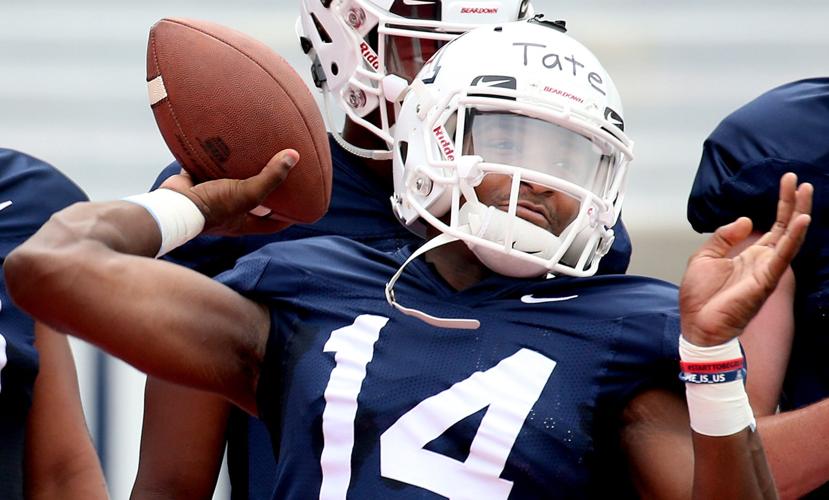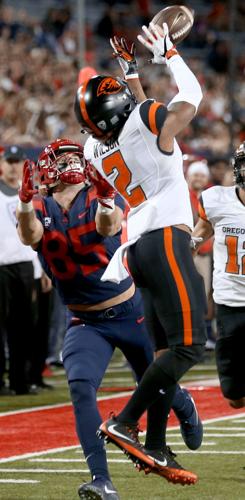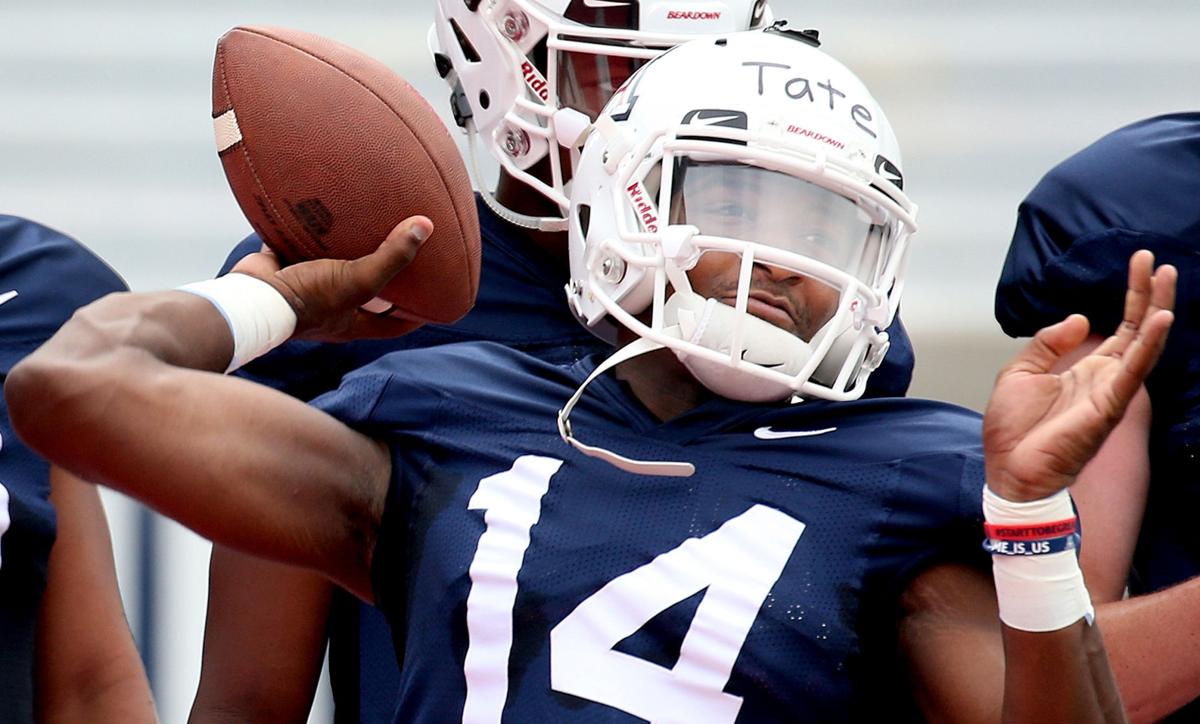Game week is almost here. Come Monday, the Arizona Wildcats will turn all of their attention to BYU, which visits Arizona Stadium for the season opener a week from Saturday. At that point, 2017 will be a distant speck in the rearview mirror.
But we still have a little bit of time to look back. Specifically, I wanted to re-examine all nine of quarterback Khalil Tate’s interceptions.
How many were his fault? Did they have a common theme? What can we learn from those turnovers?
Let’s go through each one and see what we can unearth.
INTERCPTION NO. 1
Opponent: Houston
Score/situation: The Cougars led 19-16 late in the fourth quarter. Arizona faced first-and-10 at the Houston 32-yard line.
What happened: Tate – despite not being 100 percent because of a shoulder injury – had entered in relief of Brandon Dawkins. On his first possession, Tate led Arizona on a 10-play, 30-yard drive for a field goal. His second ended with a pick by Garrett Davis. The pass was intended for Shun Brown, who lined up in the right slot. Tate hesitated, threw late and slightly behind Brown, who didn’t run a crisp route. You can see the play at the 3:57 mark below.
Analysis: Tate didn’t need to force the ball under those circumstances. The interception happened with 3:49 left. Arizona already was within range to attempt the tying field goal.
INTERCEPTION NO. 2
Opponent: Cal
Score/situation: The game was tied, 31-31, late in the fourth quarter. Arizona faced third-and-6 at the Cal 43. The Wildcats snapped the ball with 43 seconds left in regulation.
What happened: Tate had Brown open underneath but forced the ball down the field to Shawn Poindexter. Poindexter misjudged the pass, and Ashtyn Davis intercepted it at the 1-yard line.
Analysis: Another instance where Tate needed to be more patient. Arizona needed just 10 yards or so to get into field-goal range. If Poindexter had tracked the ball better, he might have caught it. But that doesn’t justify the decision Tate made.
INTERCEPTION NO. 3
Opponent: Washington State
Score/situation: Arizona was leading 23-20 early in the third quarter. The Wildcats faced second-and-5 at their 30-yard line.
What happened: Tate threw a pass over the middle intended for Poindexter. Jahad Woods intercepted it. But the play should have been overturned by penalty. As I wrote at the time, WSU’s Marcellus Pippins “clearly contacted Poindexter before the ball arrived.
Analysis: Blown call. Shouldn’t have been an interception. Not Tate’s fault in any way.
INTERCEPTION NO. 4
Opponent: USC
Score/situation: After rallying to tie the game, Arizona had just fallen behind 42-35. The Wildcats faced first-and-10 from their 25 with 5:37 remaining in the fourth quarter.
What happened: After a play-action fake, Tate rolled to his right. Although Devaughn Cooper was open underneath, near the right sideline, Tate elected to fire the ball downfield toward Tony Ellison. The pass was off the mark, and USC’s Ajene Harris picked it off. You can see the play at the 2:21 mark below.
Analysis: Another case of Tate trying to do too much. He and Ellison didn’t seem to be on the same page – you can see how far off the pass was. But again, it’s more about the decision than the execution.
INTERCEPTION NO. 5
Opponent: USC
Score/situation: Now trailing 49-35, Arizona faced third-and-8 at its 37 with less than three minutes remaining.
What happened: Tate fired a strike into the chest of a backpedaling Brown. But Brown bobbled the ball, and it bounded into the arms of linebacker John Houston for the game-clinching interception. You can see the play at the 2:52 mark below.
Analysis: Another one that wasn’t Tate’s fault. The pass couldn’t have been thrown any better, and if the normally sure-handed Brown had hung on to it, the Wildcats would have had a first down.
INTERCEPTION NO. 6

Oregon State cornerback Shawn Wilson made a smart play to intercept Khalil Tate.
Opponent: Oregon State
Score/situation: Arizona led 7-0 about midway through the first quarter. The Wildcats faced first-and-10 at the Beavers’ 34-yard line.
What happened: Tate lofted a pass for tight end Jamie Nunley down the right sideline. It was a well-thrown ball, but Oregon State DB Shawn Wilson picked it off.
Analysis: Great, heady play by Wilson. As I wrote at the time, Wilson “appeared to peel away from an underneath route to pick off Tate at the 5-yard line.” With another year of experience, Tate might recognize that situation and either put more zip on the ball or go elsewhere. But the truth is, the other guys just win sometimes.
INTERCEPTION NO. 7
Opponent: Oregon
Score/situation: Arizona trailed 28-21 late in the first half. The Wildcats faced second-and-10 from their 25-yard line.
What happened: After a play-action fake, Tate drifted to his right. He tried to force the ball to Ellison in a crowd. Ugochukwu Amadi picked it off at the UA 32. You can see the play at the 5-minute mark below.
Analysis: Ellison simply wasn’t open. One got the sense that Tate was pressing in a game in which Arizona’s banged-up defense was having major trouble stopping Oregon’s offense. Amadi almost intercepted Tate’s previous attempt, which was a little late and a little behind Ellison near the right sideline.
INTERCEPTION NO. 8
Opponent: Oregon
Score/situation: The Ducks led 48-28 with less than a minute left. The Wildcats faced first-and-10 at the Oregon 35.
What happened: After a straight dropback, Tate scrambled to his right. Under pressure, he chucked the ball into the end zone. Ty Griffin stepped in front of Brown to intercepted it. You can see the play at the 9:52 mark below.
Analysis: It wasn’t technically a Hail Mary, but it might as well have been. Tate was just trying to make something happen. The game already had been decided. One could argue that neither he nor Brown should have been playing at that point.
INTERCEPTION NO. 9
Opponent: Purdue
Score/situation: The Boilermakers led 38-35 with less than 90 seconds left in the Foster Farms Bowl. Arizona faced third-and-10 from its 32.
What happened: Brown initially ran a hook route to the right side. When he saw Tate scrambling, Brown started to run up the field. Tate overthrew him by several yards. Jacob Thieneman had an easy interception to ice the game. You can see the play at the 2:22 mark below.
Analysis: I asked Tate about this play at Pac-12 Media Day, and he chalked up to him and Brown not being on the same page. Indeed, Tate thought Brown would keep running. Instead, he stopped around midfield. I’m not sure they would have connected even if Brown had kept going.
So what can we glean from all this? A few takeaways:
- Two of the picks – the one against Washington State and the second one against USC – weren’t Tate’s fault.
- Most of the ones that were fall under the category of Tate trying to do too much. He’s extremely competitive, and that sometimes can work against a quarterback. With more experience, he should make better decisions this season.
- Finally, there’s a lot that goes into any given play. It’s easy to blame everything on the quarterback, but it’s also unfair. Tate’s receivers weren’t exactly where he thought they would be on some of those picks. Although they’re playing in a new system, Brown, Poindexter and Ellison should benefit from a full offseason of working with Tate as the clear No. 1 quarterback.
How do Sumlin, Tate rate? Ranking the Pac-12 coach-quarterback combinations
Who's the leader of the Pac?
Updated
Southern California players and coaches celebrate after beating Stanford in the 2017 Pac-12 championship game in Santa Clara, California.
Who has the best head coach-quarterback combination in the Pac-12? Who has the worst? Where do the Arizona Wildcats fit in?
We answer all those questions with our HC-QB Combo Rankings. We ranked the coaches 1-12, as well as the quarterbacks (or in some cases, quarterback situations). First place was worth 12 points, second place 11, etc. We then added it all up. Here’s how it came out (rankings within each category in parentheses; ties broken by higher ranking in coach category):
No. 1 Washington
Updated
Washington quarterback Jake Browning
Coach: Chris Petersen (1)
Quarterback(s): Jake Browning (2)
Comment: Peterson won big at Boise State, and he’s winning big at Washington, including back-to-back seasons with double-figure victories and the conference’s lone College Football Playoff berth over the past three years. No Pac-12 passer has more experience than Browning, who has compiled a 78-24 TD-INT ratio, a 64.4 percent completion rate and a 153.3 rating in his three years as a starter.
No. 2: Stanford
Updated
Stanford quarterback K.J. Costello
Coach: David Shaw (2)
Quarterback(s): K.J. Costello (5)
Comment: Shaw took the baton from Jim Harbaugh and hasn’t stopped running, winning 10 or more games in five of seven seasons at the school with the most stringent academic standards in the Pac-12. Costello showed great promise in his first year as the starter, fashioning a 14-4 TD-INT ratio, but still must prove he can do it over the long haul.
No. 3: Arizona
Updated
Arizona quarterback Khalil Tate (14) slices through the Northern Arizona defense in the third quarter of their game Sept. 2, 2017.
Coach: Kevin Sumlin (6)
Quarterback(s): Khalil Tate (1)
Comment: Sumlin won 67.3 percent of his games at Houston and 66.2 percent at Texas A&M; either would rank as the highest mark at Arizona for any coach over the past 40 years. Tate doesn’t have the experience of Browning or the NFL measurables of Oregon’s Justin Herbert, but if you were drafting Pac-12 quarterbacks for the 2018 season, is there anyone you’d rather have?
No. 4: Utah
UpdatedCoach: Kyle Whittingham (4)
Quarterback(s): Tyler Huntley (7)
Comment: Those who didn’t think Utah could win consistently in the Pac-12 underestimated Whittingham, who has led the Utes to four straight bowl appearances and a 35-17 record over that span. Huntley can run (537 yards, six TDs), completed a high percentage of his passes a year ago (63.8) but needs to cut down on turnovers (15-10 TD-INT).
No. 5: Oregon
UpdatedCoach: Mario Cristobal (9)
Quarterback(s): Justin Herbert (3)
Comment: This isn’t Cristobal’s first rodeo; he led a moribund Florida International program – which went 0-12 prior to his arrival – to winning seasons in Years 4 and 5. Herbert has star potential and the eyes of the NFL upon him; he just needs to prove he can stay healthy and produce for a full season after missing five-plus games last year.
No. 6: UCLA
UpdatedCoach: Chip Kelly (3)
Quarterback(s): Wilton Speight/Dorian Thompson-Robinson/Devon Modster (10)
Comment: If we were doing this in 2012, Kelly would rank No. 1; he went 46-7 in his four seasons at Oregon but drops a couple of notches over concerns about whether he can approach that success now that many have co-opted his methods and schemes. Speight completed 61.6 percent of his passes with an 18-7 TD-INT ratio at Michigan in 2016; Thompson-Robinson fits Kelly’s system better and is the quarterback of the future, if not the present.
No. 7: Colorado
Updated
Colorado quarterback Steven Montez
Coach: Mike MacIntyre (8)
Quarterback(s): Steven Montez (6)
Comment: MacIntyre led the Buffaloes to the Pac-12 Championship game in 2016, but that’s their only winning season on his watch, and he could be in trouble if they don’t make a bowl game in ’18. Colorado’s success hinges largely on Montez, a redshirt junior with NFL tools and measurables who must become more consistent after an up-and-down ’17 campaign.
No. 8: Arizona State
UpdatedCoach: Herm Edwards (11)
Quarterback(s): Manny Wilkins (4)
Comment: Even Edwards’ most ardent supporters can’t dispute these facts: He was a sub-.500 head coach in the NFL (54-74) and hasn’t coached in college since 1989, when he was the defensive backs coach at San Jose State. Wilkins is probably the most underrated QB in the Pac-12; he completed 63.4 percent of his passes and accounted for 27 touchdowns last season while leading ASU to the Sun Bowl.
No. 9: Washington State
Updated
Washington State coach Mike Leach
Coach: Mike Leach (5)
Quarterback(s): Gardner Minshew/Trey Tinsley (11)
Comment: Leach posted 10 straight winning seasons at Texas Tech; his overall winning percentage at WSU — maybe the hardest place to recruit to in the Pac-12 — is just .500, but the Cougars are 26-13 over the past three seasons. Leach’s quarterbacks always put up prolific numbers; if grad transfer Minshew wins the job, he could surpass the stats he totaled in two seasons at East Carolina (3,487 yards, 24 TD passes).
No. 10: USC
Updated
USC quarterback Jack Sears
Coach: Clay Helton (7)
Quarterback(s): JT Daniels/Jack Sears (9)
Comment: Helton has gone 21-6 in his two full seasons as USC’s coach, including a Rose Bowl win and a Pac-12 championship, yet a segment of USC’s hard-to-please fan base still isn’t sure he’s the right man for the job. Daniels might be the next great Trojans QB, but it’s hard to rank a true freshman ahead of any established veteran, no matter how high Daniels’ upside might be.
No. 11: Cal
Updated
California quarterback Ross Bowers
Coach: Justin Wilcox (10)
Quarterback(s): Ross Bowers (8)
Comment: Wilcox got off to a promising start, going 5-7 with wins over North Carolina, Ole Miss and Washington State, but must prove himself over the long haul at a place that lacks the infrastructure of many of its Pac-12 rivals. Bowers needs to build off his finish to 2017; he had only four interceptions in his final eight games after throwing eight in his first four.
No. 12: Oregon State
Updated
Oregon State coach Jonathan Smith
Coach: Jonathan Smith (12)
Quarterback(s): Jake Luton/Jack Colletto/Conor Blount (12)
Comment: This is the first head-coaching job for Smith, who returned to Corvallis (where he played quarterback) after a successful four-year run as the offensive coordinator/QB coach at Washington. That once-touted JC transfer Luton didn’t quickly pull away from the competition in spring or training camp probably isn’t a good sign for the downtrodden Beavers.






